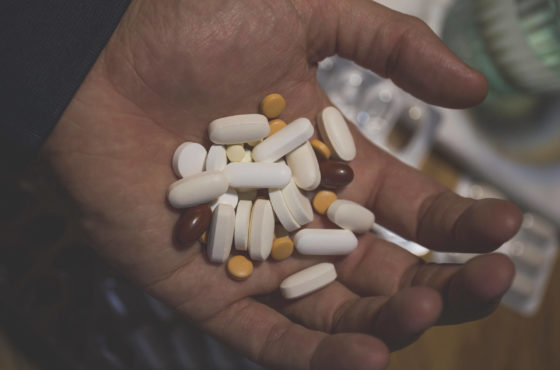Opioids or opiates are drugs that are prescribed to treat pain.
Prescription opioids include oxycontin (oxycodone), vicodin (hydrocodone and acetaminophen), dilaudid (hydromorphone), and morphine.
Opioids can also include opiates like codeine, heroin, morphine, and opium.
And although they are very effective in the treatment of several forms of acute and chronic pain in patients, they also come with the risk of physical dependence and one may eventually suffer from opioid addiction.
This means that people can quickly become tolerant of these drugs and eventually rely on them to prevent withdrawal symptoms.
This huge potential for substance abuse led to the opioid epidemic in America. Opioid use and abuse has been a long-standing concern in the country until now.
According to the Centers for Disease Control and Prevention, from 1999 to 2018, 450,000 people died due to an overdose from any opioid, including illicit and prescription opioids.
Today, an increasing number of people who fell victim to the ongoing opioid epidemic are now filing opioid epidemic lawsuits. Plaintiffs say that these opioids or opiates are associated with serious side effects such as confusion, urinary retention, and chronic constipation, just to name a few.
Cutting back on these drugs will give you a number of opioid withdrawal symptoms.
What is Opioid Withdrawal?
Opioid withdrawal is a potentially life-threatening condition caused by opioid dependence.
Opioid withdrawal comes in a set of symptoms that arise from a sudden stop in taking opioids right after you have become physically dependent on them and basically have relied on them to avoid experiencing opioid withdrawal symptoms.
You may experience these physical symptoms of opioid withdrawal once you have decreased the amounts of opioid or totally stopped taking them at all.
Basically, patients suffer from opioid use disorder because opioids attach themselves in the receptors on nerve cells in our brain and spinal cord to block pain signals that your body is sending to your brain.
Opioids also make your brain release dopamine, a chemical that influences a person’s mood and makes us feel good.
Opioid withdrawal symptoms develop because your body is adjusting with the absence of opioids in your system.
Causes of Opioid Withdrawal
When you have taken large amounts of opioids for a long time, you become tolerant and need to progressively increase the dosage of the opioids that you take.
This is very dangerous as a missing dose of opioid may cause someone to suffer from withdrawal and increases their risk of fatal overdose.
Taking opioids for a prolonged period changes how nerve receptors function in your brain, and over time, patients become dependent on the drug to keep functioning normally.
Withdrawal symptoms become present when patients stop taking opioid medications after being physically dependent on the substance. This is how your body responds to the absence of the drug in your system.
Once addicted to opioids, patients become desperate not to miss a dose in order to prevent pain or withdrawal symptoms.
In many cases, people hardly recognize opioid dependence. They may mistake symptoms of withdrawal for the flu, as opioid withdrawal may show characteristics that resemble the flu. These signs can include nausea, vomiting, muscle aches, runny nose, leg cramping, and diarrhea, among others.
Symptoms of Opioid Withdrawal
Opioids are used to manage severe pain. Opioids include morphine, oxycodone, codeine, heroin, opium, methadone, and hydromorphone.
Prescription opioids
Illicit drugs like heroin are also opioids. Methadone is an opioid often given as a treatment for pain, but can also be used in treating withdrawal symptoms in people who suffer from opioid addiction.
Several factors will determine the withdrawal symptoms you are going to experience. They will depend on things like how long a patient has been using opioids, and the level of withdrawal one is experiencing.
The most common signs of opioid withdrawal include:
- muscle aches
- anxiety
- restlessness
- yawning
- runny nose
- lacrimation (watery eyes)
- sweating
- fever
- belly cramps
- shaking
- high blood pressure
- abdominal cramping
- goosebumps
- nausea
- vomiting
- hallucinations
- dilated pupils
- seizures
These symptoms of opioid withdrawal can show up 12 hours after you stop using the medication.
Usually, you will begin to notice improvements on these withdrawal symptoms within 72 hours, and after a week, the more serious symptoms of opiate withdrawal should significantly decrease.
It is important to note that different drugs can remain in your system for different lengths of time and this can heavily affect your withdrawal symptoms.
Specifically, the severity of your addiction and your overall health will dictate the duration in which your symptoms will last.
Heroin, for instance, tends to get eliminated from one’s system faster, and symptoms will begin within 12 hours after you take the last dose of the drug. Methadone, on the other hand, may take a day and a half before symptoms begin.
How is Opiate Withdrawal Diagnosed?
To diagnose opioid withdrawal, your health care provider may perform a physical examination and ask about your symptoms. They might also do urine and blood tests to identify which drugs you have used.
A test known as the Clinical Opioid Withdrawal Scale (COWS) can help your health care provider determine how serious your case might be.
You may also be asked about your medical history and past drug use. To get the best treatment, patients should cooperate and answer the questions from their doctor honestly.
Opioid Withdrawal Treatment
Opioid withdrawal can prove to be very hard and uncomfortable for anyone. And since it can be difficult to avoid opioids safely, seeking the help of a doctor for treatment may give you greater chances of successfully quitting opioids.
Over-the-counter drugs like ibuprofen, acetaminophen (Tylenol), and aspirin, can be used to treat milder opioid withdrawal symptoms. Methadone may also help suppress your cravings, and plenty of fluids is also important.
Suboxone is a pill that has two different medicines inside, buprenorphine and naloxone. Buprenorphine is a mild opioid, while naloxone is an opioid blocker. Unlike other opioids, suboxone does not produce many addictive effects.
Naloxone, the opioid blocker, is mainly used to prevent constipation. Once injected, it can immediately cause withdrawal, so the medication has less potential for drug abuse.
When taken by mouth, this medication can also help treat symptoms of opioid withdrawal and can shorten the recovery period of a patient from other much dangerous opioids.
Medications like loperamide (Imodium) may also help settle your stomach if you are experiencing vomiting or diarrhea.
You may also be given medications to manage your blood pressure if it has risen because of opioid withdrawal symptoms.
On the other hand, more serious symptoms of opioid withdrawal may mean hospitalization and use of other medications. The medication Clonidine is primarily used to treat more severe opioid withdrawal symptoms. Clonidine helps reduce the severity of withdrawal symptoms by 50 to 75 percent.
It is also helpful in reducing muscle aches, runny nose, restlessness, anxiety, sweating, and cramping.
Opioid Withdrawal Complications
Opioid withdrawal is not always life-threatening. The effects of withdrawal only become a bigger problem when you have other underlying health issues. For instance, a blood pressure can cause other problems if you have a heart condition.
Diarrhea is another opioid withdrawal symptom which can lead to other health problems. Loss of fluids and electrolytes can cause the heart to beat abnormally, which can result in circulatory problems and heart attack.
Vomiting along with diarrhea can also lead to dehydration and heart failure. But even if you do not experience vomiting, nausea alone can be very uncomfortable. You may also experience joint pain and muscle cramps during opioid withdrawal.
The good news?
Your care provider will be with you in choosing medications that will help you cope with these unsettling withdrawal symptoms.
It is also important to remember that a patient can also have other withdrawal symptoms that are not present or mentioned in this article. This is why working with your doctor is very important during the whole process of opioid withdrawal.
There’s More That You Can Do
Overall, seeking help for opioid addiction will be worth it. It will significantly improve your physical and mental health, and will reduce your risk of accidental overdose, relapse, and other complications associated with opioid addiction.
Aside from looking for support groups and talking to your doctor, another path you can take is fighting for you and your loved one’s rights by filing an opioid epidemic lawsuit.
If you or a family member has suffered from the effects of opiate abuse and addiction, the time to seek justice against abusive opioid manufacturers has come.
Do not hesitate to contact us, and we will help you by providing you with the necessary legal steps you can take to make the culprits accountable.
Or you can also share with us your story about opioids or opiates and how you amazingly fought the battle against these substances in the comment section.




